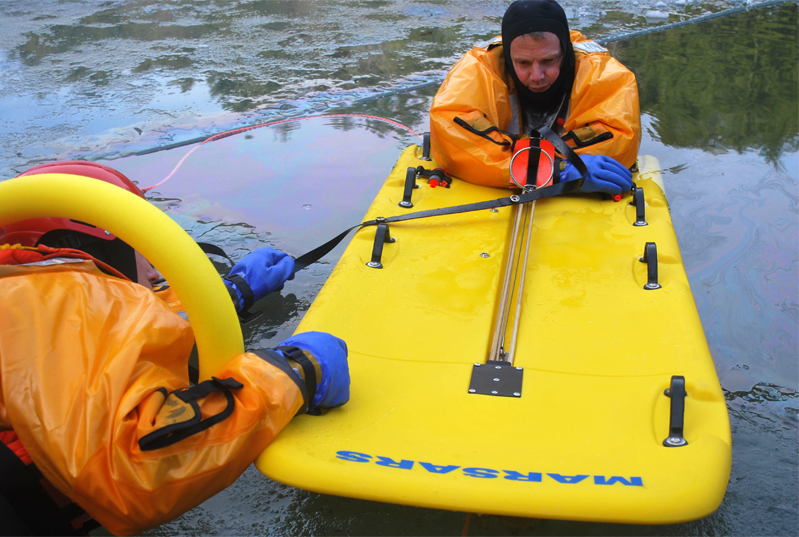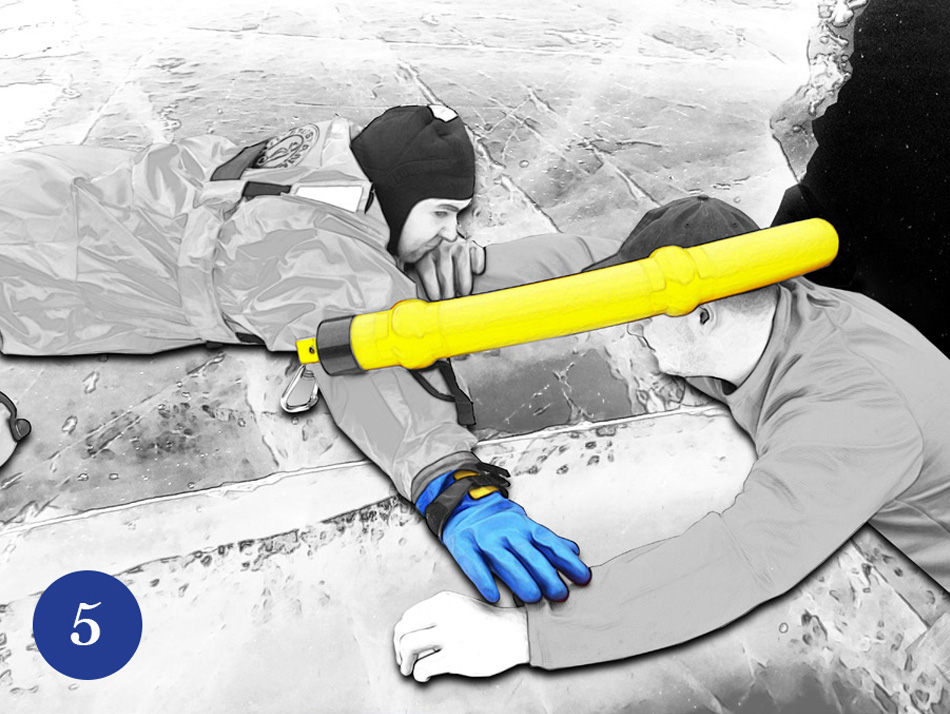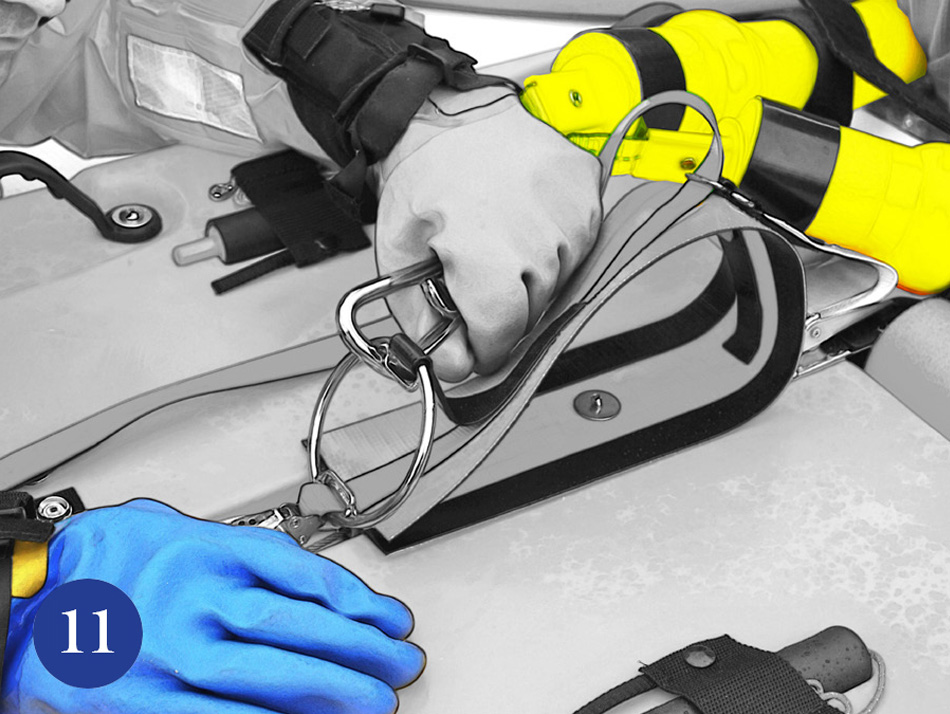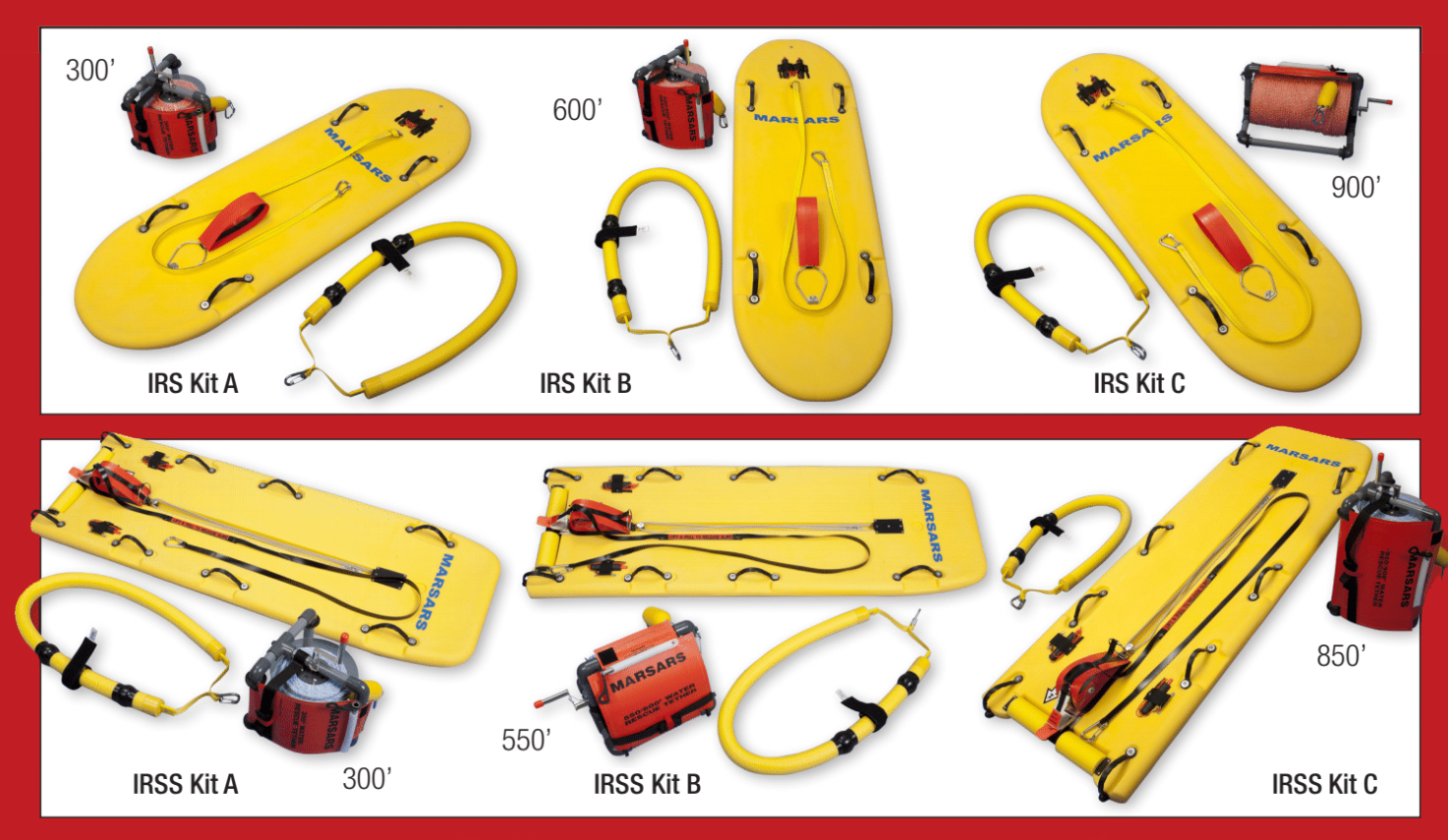A Proven Success With Less Time & Manpower.
A seed change for ice rescuer’s safety
In this high-risk low incident environment, the MARSARS® Ice Rescue Sled (IRSS Sled) is the first ice rescue device designed to gently extract the victim from a safer distance. As first responders, we must be mindful of the rescue dictum: Self-Rescue, Reach, Throw, Row, Go. The self-rescue, reaching phase of this principal has been incorporated into the design of this unique mitigating device for high-risk situations.
Genesis of Safer Distance Ice Rescue
Prior to late 80’s, if grabbed and climbed on, all lifeguards were trained to escape by submerging their body deeper. Doing so, the panicked victim, desperate for support would let them go. Since then, all lifeguards stop at a safe distance and extend a rescue flotation device (RFD). The use of RFDs has become the nucleus of swimmer’s safety in open water rescue. However, if an ice rescue technician is grabbed and climbed on, the ice rescue suit’s buoyancy prevents escape, leaving our techs no recourse but to make aggressive moves to escape.





Testimonials



“I was assigned to teach an ice rescue class at a department that just bought a MARSARS® ice rescue sled. After studying the instructions, watching the DVD, and performing well over 100 rescues teaching that class,
I was sold.”
“The Shutesbury Fire Department has been involved with surface ice rescue for many years. We have evaluated many products over the years, searching for a product that would make the process easier and safer for all involved. The MARSARS® Ice Rescue Safety Shuttle is the most innovative piece of equipment for ice rescue that we have seen.
We ordered the Safety Shuttle with a 300’ Ice Rescue Reel and Sling. We were impressed by the quality of the construction and the many integrated features. After some classroom training including instructional videos, we put it through some real world testing.
Everyone was impressed with the ease of use. We tested the Shuttle at night in realistic conditions using both “conscious” and “un-conscious” victims. Even with multiple evolutions, ice buildup and other equipment freeze ups, the Shuttle continued to perform great. We even had firefighters new to ice rescue performing recues with ease. Also notable was the reduced stress and strain on the patient.
All-in-all, the best ice rescue product for we have ever used!”
“I would like to offer my full endorsement to MARSARS® Company; I have been using this equipment both in my current position as Deputy Chief of Operations for the Corner Brook Fire Department, as well as with my former position as the Operation Manager of the Marine Institute Safety and Emergency Response Training Center (Newfoundland, Canada).
Over the past 10 years, I have used several different types of Ice and Water rescue equipment, both in training and in actual rescue operations. I have been directly involved in the Fire Rescue Service for 31 years, 21 of which I worked with the Marine Institute in their fire rescue training division. I feel the equipment offered by MARSARS® is by far the most user friendly and easy to operate equipment there is on the market today. The simple operations allows rescuers to gain quick access to would be victims in minimal time while being 100% plus safe.
I feel that the MARSARS® system is by far the best Ice and Water rescue equipment we have used to date and would recommend this equipment to any type of Ice/Water rescue organization.”
“My rural fire rescue service chose MARSARS® after looking at all the alternatives. The average age of my responders is somewhere over 62. And there are only ten of us. So an ice rescue system had to leverage our brains to overcome the lack of brawn. The ice shuttle system allows us to use the combined strength of shore rescuers to do the hard work. We are very happy with how this is working for us.
A very big advantage of working with MARSARS® is the depth of experience that they have. They have seen so many practice and actual rescues and have incorporated the lesson learned into their system. We feel confident that we will not have to reinvent a system and that solutions to the many challenges of ice rescue have already been designed into the MARSARS® system.
As both a fire chief for many years and Executive Director of the FIRE Institute, I can recommend MARSARS® without reservation.”




The future of modern ice rescue
A safer distance, a smaller team
The Two Responder Trial
In January 2019, Sodus Point Fire Department purchased a MARSARS® Ice Rescue Safety Sled (IRSS) kit. Upon receipt of this order, Fire Chief Mark Jones Jr. and Deputy Chief Chuck Sargent were eager to assess the sled’s safer-distance ice rescue capability. The officers brought the equipment down to the partially ice-covered Sodus Bay in New York. Upon arrival, the deputy chief assumed the role of rescue technician, traversed outbound over the ice, and entered open water. Switching to the role of victim/patient, he placed both forearms through the sled’s forearm sling. When signaled, and through the aid of the sled’s unique 4:1 ratio pulley system, Chief Jones, by himself, weighing only 165 pounds, effortlessly hauled his 240-pound deputy aboard the sled, onto the ice shelf and back to shore.
This trial proved to the department that only two ice rescuers are initially needed to quickly deploy, extract, and recover a patient. Nationwide, with fire departments challenged by limited numbers of first responders, this simple to operate device has become a real game changer.
Subsequent Rescue with Minimal Responders
On March 14, 2019, Sodus Point FD received a call concerning a four-wheeler with two men that had fallen through the ice 1,000 yards (914 meters) from shore. The department’s air boat was dispatched. After numerous ice fisherman were found to be fishing in the vicinity of the launch ramp, the air boat was aborted. Without delay, Chief Jones Jr. alongside an ice rescue technician and safety observer then responded. When the three responders arrived on scene they found that one of the victims had self-rescued. The weight of the other still immersed victim was estimated to be 350 pounds. With an empty IRSS Sled extended, and the patient’s forearms through the forearm sling, the Chief extracted the large patient atop the sled, and brought the sled with patient onto the ice shelf by himself.
The Two-Victim Rescue Trial
The IRSS sled is wide enough to rescue two side-by-side patients at one time. This past winter, a test was conducted by the Caledon
Fire & Emergency Service in Ontario to evaluate the IRSS Sled’s two-victim rescue capability. To understand this technique, picture yourself standing on safe ice behind both side-by-side victims. You are now facing their backs. To their front, the rescuer has stopped one sled-length away. The size-up determined they both possess the ability to assist in their own rescue. As a reaching device, the empty IRSS Sled was extended to them. The victim to your right was instructed to insert his right forearm through the sled’s forearm sling. The victim to the left inserted his left forearm. Now both patients were facing one another and told to hold on to each other with their free arm. Only one line tender responder was needed to load both adult males onto the sled and secure them atop firm ice.
The Rescue and Recovery Incident
In the Great Lakes, the MARSARS® Ice Rescue Safety Sled is carried aboard U.S. Coast Guard airboats. On January 29, 2015, U.S. Coast Guard Station Saginaw River in Essexville, Michigan, responded to a report that two men fell through the ice near a powerplant. Station Saginaw River crew responded aboard a 20-foot airboat, arrived on-scene, quickly located and rescued by IRSS Sled then transported the first individual. The crew was informed during transport that a second snowmobile operator had fallen through and died. Returning to the scene after transfer, the gloved hand of the second victim was observed protruding from the icy water. A quick and physically effortless extraction was made by inserting one forearm through the sled’s sling and holding the unresponsive victim’s wrist.
These four incidents show how versatile and efficient modern ice rescue can be with the MARSARS® Ice Rescue Safety Sled kit.
The technology is truly a game changer.



Ice Rescue Safety Sled
Kit Features:


- High-density polyethylene hull
- Rescuer’s tether strap
- Built in Body Roller
- Victim Forearm Sling (VFS)
- Concave deck, tunnel-shaped hull
- 8 Carry Handles
- Approximate 240 lbs. of buoyancy
- 4:1 ratio extraction system
- Buoyant sling connection ring
- Forearm Sling Brake
- Ice Awls
- Pre-rigged for immediate use
Safer Distance Ice Rescue
Many consider the use of this unique rescue from a safer distance device as a real game changer that minimizes the risk of injury to the patient as well as risk of injury or viral exposure to the rescuer
- Many consider the use of this “rescue from a safer distance” device as a “best practice” that avoids rescuer’s risk of injury during extrication
- Initially, a minimum of two first responders are needed for rescue
- All MARSARS® IRSS sled kits are one-person portable
- The sled is pre-rigged ready for instant use within seconds
- Only one out-bound ice rescue technician is required
- On-scene, rescuer remains a safe, one sled-length away from the victim
- Most conscious and alert victims can insert their forearms through the sled’s forearm sling
- For size-up, victim is asked to lift and lower one arm. If conscious and alert…
- Empty sled is extended as a “REACHING DEVICE” for the victim “SELF-RESCUE ATTEMPT”
- Only one shore-based responder is needed to extricate the patient
- IRSS Sled can extricate two patients at one time
- Patient is gently handled from ice to ambulance
- Service life: 23 years and counting
Rescuing the Unresponsive Victim
Glove of Dominate Hand is Blue

Atop ice, rescuer makes a cautious 45° angle approach to the victim. Dominate hand grabs victim’s wrist

Holding wrist, rescuer’s free hand grabs sling low to extend sling far

With victim’s wrist raised, slide sling beneath arm

A fully extended sling should now rest behind victim’s head

Place and hold victim’s wrist atop the sling. Rescuer’s dominate hand reaches through sling to grab victim’s other wrist

Victim’s arm is lifted up, over and to the side of sling

With sling lifted, dominate hand reaches beneath sling and grabs tail of the adjustable strap

The sizing strap is now wrapped and fastens around both legs of sling

Ice rescue technician pulls sled within close reach

Victim Forearm Sling’s brake is released

Buoyant rescue sling is connected to the sled’s ring attached pulley system

From ice to ambulance
Returning sled shields torsos of both patient and rescuer. Improved rescue safety with minimal patient handling and physical stress is the result of this well thought out ice-to-ambulance extraction device.

More Game Changing Products From MARSARS®
Cold Water Rescue Sling
This safety device is designed for the rescuer to remain atop ice, thus, reducing risk of injury. The sling is extendable by hand or reach pole. When donned, it provides most patients with independent positive buoyancy. During extrication, with arms folded atop the sling, patient’s head is protected. If pulled through thick heavy snow, this non-constrictive device prevents compression injury to the patient’s chest.

Ice Rescue Reel
The MARSARS IRSS Safety Sleds are sold with a 300’, 550’, or 850’ reel. These reels are loaded with a buoyant hollow braided line of 3,500 lbs. MBS line. When wet, this coreless tether line remains light. Less weight = less drag = faster outbound speed. Additionally, hollow braided rope prevents the IRSS sled’s 4:1 ratio pulley system from disabling damage caused by a twisted or hocked pulley rope.


Rapid Underwater Recovery Kit
In 1995, the Warwick RI Fire Department conducted a recovery of three boys that had tragically drowned in 10-1/2 foot of water. Due to depth, the bodies were recovered in 10, 20, and 43 minutes. Two of the three recovered children were revived. Years later, the child that took the most time to recover graduated from college. During either summer or winter recovery, the Rapid Underwater Recovery Kit is another game changing tool for your toolbox that saves time, risk of injury and brings hope or closure to a grief stricken family.

Second Chance Rescue Throw Bag
Second Chance Rescue Throw Bag is a ball weighted heaving line packed within a throw bag backwards. During rescue, the MARSARS 75’ throw bag with ball can be thrown, if needed, retrieved and accurately re-thrown to a full distance within 20 seconds.
For fleet purchase considerations, call today to receive a free 30 day trial offer


IRS Sled
MARSARS Ice Rescue Extrication Sled®
How it works
This tough little sled comes to you pre-rigged, ready for instant use. The responding rescuer equipped sled is either dragged behind or traversed atop, obviously, the sled is designed to get you on-scene quickly. In fact, propelled over smooth early winter ice, this lightweight hand powered (by ice awls) sled has been clocked to a speed of 14 miles per hour. Upon arrival on scene, sled is stopped and dismounted one sled length away from the victim. Becoming a reaching device, the empty sled is extended for the victim’s self-rescue attempt. If the cold water immersed victim is found to be drained of strength, the rescuer must move closer and insert the sled between himself and the weakened victim. The victim is then outfitted with a buoyant MARSARS Cold Water Rescue Sling that is fastened to the sled’s large topside metal ring. Rescuer pushes one end of the sled underwater and easily loads patient on the partially submerged device. Returning sled shields torsos of both patient and rescuer.
- Affordably priced
- Replaceable runners
- Tunnel shaped hull reduces drag
- Approximate buoyancy 180 pounds (81.64 kg)
- 72” length x 24” width x 7” height. Weighs only 25 lbs.
- Sled’s sides and ends have been rounded to prevent injury
- Compact size is easily stored in most vehicle compartments
- Constructed of foam flled high density polyethylene plastic


